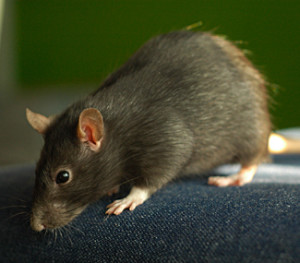What Could Be Living in the Wall?
By Chris Williams on April 15, 2015.

Did this Portsmouth home have rats living in the wall? Mice? Or something else? Sometimes you never know.
Problem: Suspicious Animal Activity
Colonial Pest Control was recently contacted by a homeowner residing in Portsmouth, NH regarding suspicious activity within their 200+ year old home. Rustling noises have been heard in 2-3 locations inside the second story walls, some chewing inside a kitchen cabinet, damage to a child’s snack cooler, and some movement of stored items. A potential water leak may or may not have been caused by an animal; that remains to be repaired. What looks like Styrofoam insulation was also being moved out of the wall void in the kitchen corner. The homeowner also set a snap trap, the type with a small metal trigger, coated with peanut butter. Two nights in a row, the animal was able to lick the peanut butter from the trigger without setting the trap in motion!
Inspection: a Surprising Lack of Evidence
Upon my inspection of the home I found easy access to the wall voids behind the kitchen cabinet that had been chewed. This is where the original trap was placed with no success. I also observed chewing on the snack cooler, and the displaced insulation in the kitchen corner. Further inspection of the cellar, a labyrinth of old foundations, showed little in the way of rodent activity. 5 rat droppings were noted, but they were not recent (very hard and dry, covered in dust). There were no signs of burrows, tunneling, or fresh droppings. Due to the nature of the old construction, animals including mice, rats, and others have ready access to wall voids from below. Due to the deep snow pack surrounding the house, no inspection of the exterior was possible. Interestingly, there were no droppings or urine stains anywhere in the kitchen that I could locate, and only 5 old rat dropping in the cellar. There were some mouse droppings in the cellar, but nothing unusual for an old house, absolutely none in the kitchen! Perplexing to say the least!
The family was scheduled to go on vacation the following day and the home would be quiet for the next week. I decided to set a couple of I.D. traps and figure out what was going on in that kitchen once and for all, before we moved on with a control strategy and plan. The first step in any pest control solution is identifying the pest at large, as control strategies differ greatly depending on the life cycle and behavior of the pest. I placed two snap traps loaded with rat attractant, and two large glue traps. Placement was such that any animal trying to enter through that cabinet or on the counter would either be killed by a snap, caught in the glue, or at least leave some fur or a clue like a dropping from the encounter. 5 days later, no activity was noted on any trap, no new chewing or movement of kitchen items, no scratching in walls.
An Unexpected Solution
There was a new development on the sixth day, a strong pungent odor of death was noted, especially in the area near where the majority of the noise was heard in the second floor wall. This likely means that what ever animal that was living and lurking in the house has died. I did not place any poison, and the homeowner’s bait placement in an over the counter child/pet resistant station was visibly untouched. What could have killed the animal in the wall?
Several things can happen to animals inside a wall. Most comensal rodents live less than two years, mice 6-10 months, rats 10-13 months. Squirrels, including the flying squirrel, grey squirrel, and red squirrel may live for over 6-10 years in the wild. In any case, all animals eventually die of natural causes (1 potential solution, it just died in the wall). Electrocution, due to contact with the home’s electrical system is also a possible scenario. 80% of unknown origin house fires are believed to be caused by some type of rodent activity. Entrapment within the wall void is certainly another possibility, after a period of time without food or water, and the stress of being unable to escape can lead to death.
As decomposition takes place, the smell is caused by the evaporation of the fluids contained within the animals membranes. As this watery fluid is evaporating, flies and other decomposers will locate the carcass and aid in it’s final breakdown. Trying to locate a dead animal is difficult at best. Without a clear staining or other evidence, it may never be found. Fortunately the odor will eventually fade, depending on the size of the animal for the final timeline of events. Bottle flies, flesh flies, or house flies may show up on interior windows 7-14 days after the death of an animal in wall voids. Flies are an indication that death has occurred.
We may never know exactly what took place in the walls at this home in Portsmouth, NH. The house is scheduled for a major renovation next year, and that may shed some light on the situation that took place. Colonial Pest Control will return and assess the situation when the homeowners return from vacation, check I.D. traps, and try to find out the cause and location of the odor if possible.
If you think you have animals in your walls, give Colonial Pest Control a call at 1-800-525-8084!
Photo credit: Sarah_Jones / Foter / CC BY-SA
Stay up-to-date with Colonial Pest’s email newsletter!